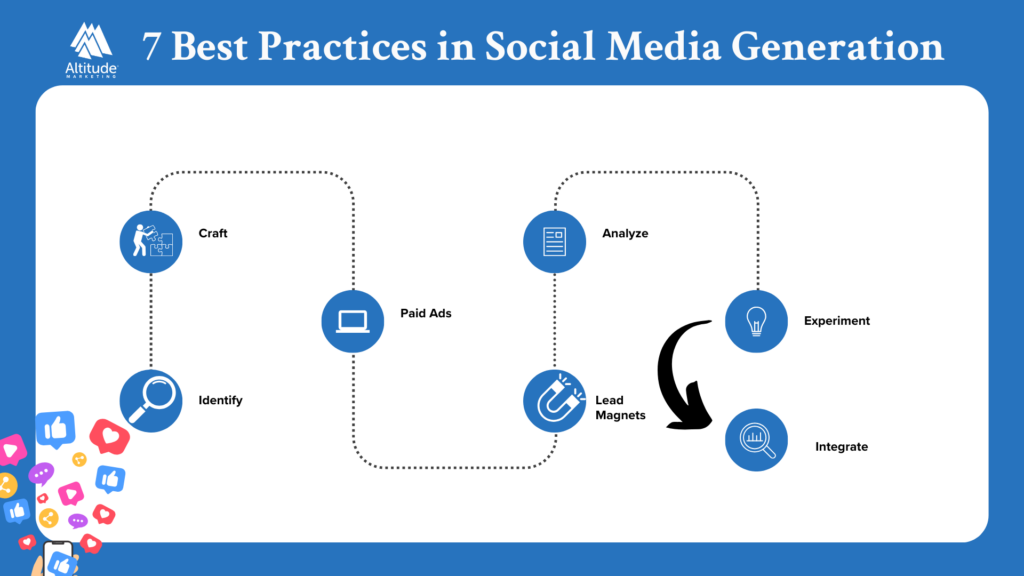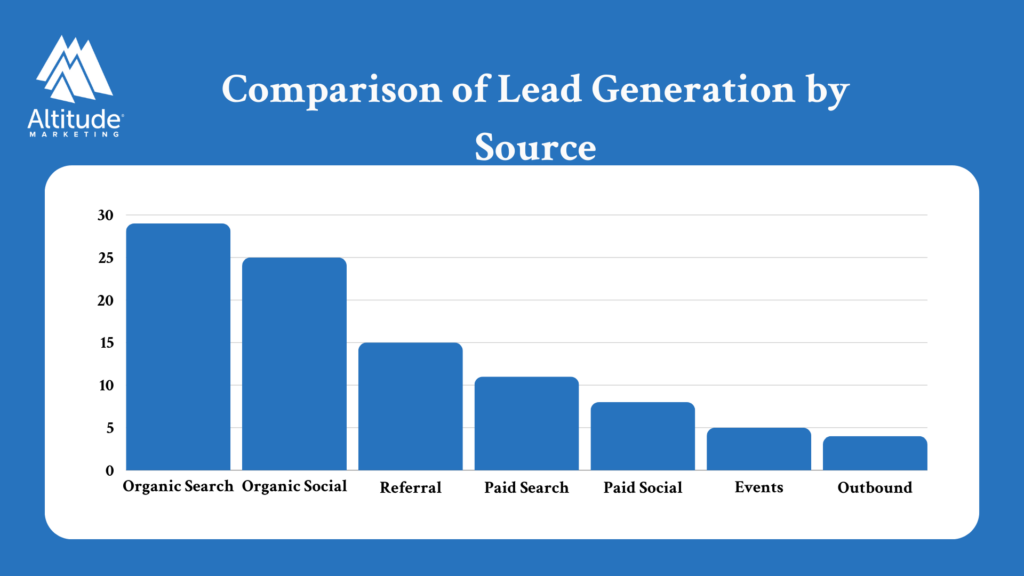Chances are high that most of your target decision makers are on social media. The challenge isn’t just to find them, but to present them with compelling content that converts.
Leveraging social media effectively for B2B lead generation requires a strategic approach and a deep understanding of the platforms and audience behavior. In this guide, we will explore the best practices and tips to ensure your social strategy pays dividends.
From understanding the B2B audience on social media to crafting engaging content, utilizing paid advertising, and integrating social media with CRM systems, we will cover everything you need to know to maximize your social media efforts and drive tangible results.

6 Social Strategies to Drive Conversion

Identify Your Audience
It’s relatively easy to talk to a lot of people on social media, but that won’t be your effective strategy. In the B2B space, you likely have an incredibly niche customer. That means you need to search for the needle in the hay stack, rather than try to appeal to all the hay.
Before you begin posting, you should:
- Define Ideal Customer Profile (ICP): Determine the characteristics of your target audience, including industry, company size, and job title.
- Research Platform Demographics: Understand the demographics of different social media platforms to identify where your target audience is most active. For example, LinkedIn is popular among professionals and decision-makers, while Twitter may be more suitable for industry news and updates.
- Prioritize Platforms: Focus your efforts on the platforms where your target audience is most active to maximize reach and engagement.
- Monitor Engagement Metrics: Track engagement metrics such as likes, shares, comments, and clicks to understand how your audience interacts with your content.
- Conduct Surveys and Polls: Gather feedback directly from your audience through surveys and polls to understand their preferences, challenges, and interests.
- Analyze Competitor Strategies: Study your competitors’ social media activities to gain insights into what resonates with the audience in your industry and identify areas for improvement in your strategy.
Craft Content That Drives Action
Every post should serve a purpose, whether that’s to drive website traffic, solicit emails, encourage asset downloads, or simply share product updates and company information. Quality social strategies provide useful content. In order to do that, you should:
- Identify Pain Points: Conduct market research and engage with your target audience to understand their most pressing challenges.
- Address Pain Points: Develop content that directly addresses these challenges, showcasing that you are a valuable tool for your audience’s interests, insights, and best practices to help your audience overcome challenges.
- Provide Value: Offer actionable advice, tips, and strategies that demonstrate your expertise and provide tangible benefits to your audience. When in doubt, calculate your company’s value with this handy tool.
- Create Educational and Informative Content: Offering how-to guides, step-by-step tutorials, and case studies can provide practical knowledge and actionable strategies to help your audience solve problems and achieve their goals, demonstrating your expertise and value.
- Use Visuals Effectively: Incorporate compelling visuals such as images, infographics, videos, and charts to make your content more visually appealing and engaging.
- Break Up Text: Break up long blocks of text with visuals to improve readability and keep your audience engaged.
- Tell Stories: Use visual storytelling techniques to convey complex ideas and concepts more engagingly and memorably, capturing the attention of your audience and driving message retention.
Use Lead Magnets and Gated Content to Capture Leads
Create compelling lead magnets, such as ebooks, whitepapers, case studies, or industry reports, that address specific challenges or provide actionable insights for your target audience.
Implement gated content strategies by requiring users to provide their contact information, such as email addresses or phone numbers, in exchange for accessing premium content. Use social media posts to promote gated content and drive traffic to landing pages where users can submit their details to access the resource.
Analyze and Optimizing Social Media Performance
Monitor and analyze key performance metrics such as engagement rate, click-through rate (CTR), conversion rate, reach, and impressions to evaluate the effectiveness of your social media efforts. Use social media analytics tools to track these metrics and gain insights into audience behavior, content performance, and campaign effectiveness.
Some tools to help analyze social media marketing strategies include Google Analytics and website traffic. Optimizing websites can for data and conversion help in tracking organic lead collection methods by showing which campaigns are effective in generating qualified leads.
Experiment with Different Content Formats and Strategies
Be agile. Algorithms and audience taste shift constantly, meaning your strategy needs to constantly adapt. Continuously experiment with different content formats, posting schedules, and engagement strategies. Changing it up can present lead generation opportunities by identifying the ideal times and content that resonates best with your B2B audience.
Test various types of content such as:
- Videos
- Infographic
- Blog posts
- User-generated content
Testing several forms determines which formats drive the highest levels of engagement and conversion. Additionally, try different targeting options, ad formats, and messaging approaches in your paid advertising campaigns to optimize performance and maximize ROI. Keep refining your social media strategy based on the insights gained from ongoing experimentation and analysis.
Integrate Social Media with Your CRM to Continuously Nurture Leads
Engagement with your audience should never live in a social media silo. Think of your social strategy like your front porch. You main mission is to open the front door and encourage them to go inside. That means you’ll want to build a nurture funnel that moves them toward conversion in other channels. Do this by:
- Syncing Social Media Channels with CRM Systems: Integrate your social media platforms with your Customer Relationship Management (CRM) system to automatically capture and sync leads generated from social media campaigns This seamless integration allows you to track social media conversations and activities across various social channels and nurture them through the sales funnel. This enables social media marketing strategy to reach a wider audience and also streamlining processes.
- Nurturing Leads Through Automated Email Sequences and Follow-Ups: Utilize marketing automation tools to set up automated email sequences and follow-up workflows. Establishing this in the lead generation strategy helps generate quality leads and nurture existing ones. Develop personalized email sequences that deliver valuable insight and offers based on leads’ interests and engagement levels. Use triggers such as form submissions, website visits, and social media interactions to automate follow-up emails and gather leads toward social media conversion.
By integrating social media with your CRM and marketing automation systems, you can streamline lead management processes and create a cohesive experience for prospects across all touchpoints.
Frequently Asked Questions (FAQs)
How can I identify the right social media platforms for B2B lead generation?
To identify the right social media platforms for B2B lead generation, start by understanding your target audience. Research where they spend their time online and which platforms align with your industry. LinkedIn is often a primary platform for B2B lead generation due to its professional networking focus, but don’t overlook other platforms like Twitter, Facebook, or even niche platforms relevant to your industry.
What types of content are most effective for B2B lead generation on social media?
Content that addresses industry concerns, offers solutions, and provides valuable insights tends to perform well for B2B lead generation. This includes informative articles, case studies, whitepapers, webinars, and other educational resources. Visual content such as infographics and videos can also be highly engaging and effective for conveying complex information in a digestible format.
How can I measure the effectiveness of my B2B lead-generation efforts on social media?
Key metrics to track for B2B lead generation on social media include engagement metrics such as likes, comments, and shares, as well as click-through rates (CTR) on your posts and ads. Additionally, monitor the number of leads generated directly from social media, as well as their quality and conversion rate. Use social media analytics tools to track these metrics and adjust your strategy based on performance.
Conclusion
By identifying target demographics, crafting relevant content, maintaining consistent branding, and integrating social media with CRM and marketing automation, businesses can maximize their efforts in generating high-quality leads and nurturing them towards conversion. With the right practices and tools in place, social media can serve as a powerful channel for driving B2B lead generation and achieving business objectives.




